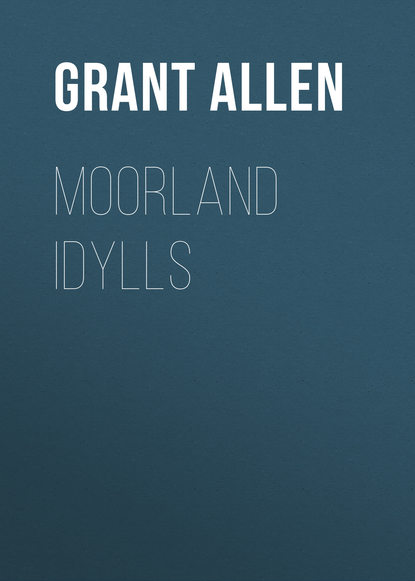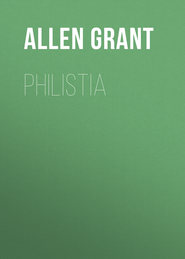По всем вопросам обращайтесь на: info@litportal.ru
(©) 2003-2024.
✖
Moorland Idylls
Настройки чтения
Размер шрифта
Высота строк
Поля
VII.
A FLIGHT OF QUAILS
It is one of the wonders and delights of the moorland that here alone Nature pays the first call, instead of demurely waiting to be called upon. Near great towns she is coy; and even in the fields that abut on villages, she shows but a few familiar aspects; while aloof on the open heath she reveals herself unreservedly, like a beautiful woman to her chosen lover. She exhibits all her moods and bares all her secrets. This afternoon, late, we were lounging on the low window-seat by the lattice that gives upon the purple spur of hillside, when suddenly a strange din as of half-human voices aroused our attention. “Look, look!” Elsie cried, seizing my arm in her excitement. And, indeed, the vision was a marvellous and a lovely one. From the lonely pine-tree that tops the long spur above the Golden Glen, a ceaseless stream of brown birds seemed to flow and disengage itself. It was a living cataract. By dozens and hundreds they poured down from their crowded perch; and the more of them poured down, the more there were left of them. What a miracle of packing! They must have hustled and jostled one another as thick on the boughs as swarming bees that cling in a cluster round their virgin queen; while as for the ground beneath, it seethed and swelled like an ant-heap. For several minutes the pack rose from its camp, and fluttered and flowed down the steep side of the moor toward Wednesday Bottom, flying low in a serried mass, yet never seeming to be finished. They reminded me of those cunning long processions at the play, when soldiers and village maidens stream in relays from behind the wings, and disappear up the stage, and keep moving eternally. Only that is clever illusion, and this was reality.
“Lonely,” people say! “No life on the hilltop!” Why, here was more life at a single glance than you can see in a whole long week in Piccadilly; an army on the march, making the heather vocal with the “wet-my-feet, wet-my-feet” of ten thousand voices!
But you must live in the uplands to enjoy these episodes. Nature won’t bring them home to you in the populous valleys. A modest maid, she is chary of her charms; you must woo her to see them. She seldom comes half-way to meet you. But if you dwell by choice for her sake in her chosen haunts, your devotion touches her: she will show you life enough – rare life little dreamt of by those who tramp the dead flags of cities, where no beast moves save the draggled cab-horse. For you, the curlew will stalk the boggy hollows; for you, the banded badger will creep stealthily from his earth and disport himself at dusk among his frolicsome cublets; for you, the dappled adder will sun his zigzag spots, and dart his tremulous tongue, all shivering and quivering; for you, the turbulent quail will darken the ground in spring, or spread cloud-like over the sky on cloudless summer evenings.
And what poetry, too, in their sudden entrance on the scene, dropped down from heaven, one would think, as on Israel in the wilderness! Small wonder the marvel-loving Hebrew annalist took those multitudinous birds for the subject of a miracle. But yesterday, perhaps, they were fattening their plump crops among the vine-shoots of Capri, the lush young vine-shoots with their pellucid pink tendrils; and to-day, here they are among the dry English heather, as quick and eager of eye as by Neapolitan fig-orchards. Swift of flight and patient of wing, they will surmount the Apennines and overtop the Alps in a single night; leave Milan in its plain and Lucerne by its lake when the afterglow lights up the snow on the Jungfrau; speed unseen in the twilight over Burgundy or the Rhineland; cross the English Channel in the first grey dawn; and sup off fat slugs before twelve hours are past, when the shadows grow deep in the lanes of Surrey. Watt and Stephenson have enabled us poor crawling men to do with pain and discomfort, at great expense, in the chamber of torture described with grim humour as a train de luxe, what these merry brown birds, the least of the partridge tribe, can effect on their own stout wings in rather less time, without turning a feather. If you watch them at the end of their short European tour from Rome to England at a burst, you will find them as playful and as bickering at its close as if they had just gone out for an evening constitutional.
Quails are the younger brothers of the partridge group; but, unlike most of their kind, they are gregarious and migratory. They spend their winters in the south, as is the wont of fashionable invalids, and come northward with the spring, in quest of cooler quarters. Myriads of them cross the Mediterranean from Africa with the early sciroccos, and descend upon Calabria and the Bay of Naples in those miraculous flights which Browning has immortalized in “The Englishman in Italy.” Quail-netting is then a common industry of the country about Sorrento and Amalfi; thousands of the pretty little gray-and-buff birds are sent to market daily, with their necks wrung, and their beautiful banded heads, “specked with white over brown like a great spider’s back,” all dead and draggled. Many of the flocks stop on during the season among the vineyards in Italy; but other and more adventurous hordes, tired of southern slugs and fat southern beetles, wing their way still further north, to Germany, Scandinavia, England, and Scotland. At one time they were far from uncommon visitors in our southern counties; but brick and mortar have disgusted them, and their calls are nowadays liker to angels’ visits than in the eighteenth century. Yet a few still loiter through the winter in Devonshire or Kerry; while in summer they still reach to the Orkneys, Shetland, and the Outer Hebrides.
Beautiful as quails are, both to look upon and to eat, they are not personally amiable or admirable creatures. Their character is full of those piquant antitheses which seventeenth-century satire delighted to discover in the human subject. They are gregarious, but unsociable; fond of company, yet notoriously pugnacious; abandoned polygamists, with frequent lapses into the strictest monogamy; fighters destitute of the sense of honour; faithless spouses, but devoted, affectionate, and careful mothers. I fancy, too, they must have a wonderful instinct in the matter of commissariat, increased, no doubt, by ages of strategical evolution: for it can be by no means easy to find supplies for so large an army on the march; yet quails seem always so to time their arrival at each temporary stopping-place as exactly to fall in with some glut in the insect-market. Only a few days before they came here, for example, not a beetle was to be seen upon the parched-up heath; but day before yesterday it rained insects, so to speak; and last night one could hardly take a step down the Long Valley without crushing small beetles underfoot, against one’s will, by the dozen. The quails must somehow have got wind of the fact that there was corn in Egypt, be it by scent, or scouts, or some mysterious instinct; and here they are to-night, swarming up in their thousands, to enter into possession of their ancestral heritage. You should see them wage war on the helpless longicorn! I hope they will nest here, as it is amusing to watch them. Each little Turk of a husband keeps a perfect harem of demure brown hens, looking slily askance from the corners of their eyes, and watches over them close by with all the jealousy of a Mahmoud or a Sultan Soleyman. The rival who tries to poach on his lordship’s preserves has, indeed, a hard time of it; he will retire, well pecked, from his rash encounter. Quails, in fact, are still in the Mohammedan stage of social evolution, while our more advanced and enlightened English partridges have attained already to a civilized and Western domestic economy.
VIII.
IN LEAFLESS WOODS
Yes: these bare boughs, I take it, are not all pure loss. They have their consolations; they have their artistic and intellectual value. They show us, after all, the true inwardness of the tree; they enable us to realize, as none could otherwise do, the infinite diversity of architecture and ground-plan in the design and execution of the forest denizens. While dense masses of foliage clothe and obscure the boughs with their gay greenery we can gain but a rough idea of the underlying structure. But just as a Leonardo or a Luca Signorelli must needs pry beneath skin and muscle to discover the actual framework and bony supports of the body, so the lover of the trees desires from time to time to catch some glimpse of the very limbs and joints of oak or maple – to get rid of the green covering in favour of the naked underlying reality. So only can one enjoy the delicate lissom twigs of the silver birch, etched in tender grey against the hard blue sky; so only can one observe the forked upright branches of the Lombardy poplar, like natural candelabra, in striking contrast with the long hanging boughs of the weeping-willow, divided and subdivided into pendulous twigs, and losing themselves at last in fine spray of living threads, like a wind-driven cataract. Every kind of forest-dweller has thus its own special beauty of architectural plan; and every one of them can be realized in all its naked grace and variety of outline only when relieved of the glorious green weight that so richly concealed it.
And bare boughs are instructive, too, as well as beautiful. They suggest to one the endless vicissitudes and cataclysms in the history of growth; they show us how the knotted trunk acquires its final form, and by what course of evolution branch added to branch builds up at last the whole noble shape of the buttressed beech or the spreading horse-chestnut. Take, for example, our dear old friend the ash. In summer you can hardly discern through a canopy of green the outline of his bent boughs, curved downwards by their own weight of heavy feathery foliage, each leaf a little branch with numerous spreading leaflets. But when autumn comes, and the heavy leaves drop off one by one, you get revealed at once the peculiar beauty of his mode of growth – that delicious combination of angular and curved form which makes the ash the acknowledged king of the winter woodland. All the branches dip gracefully in a long arch towards the end, and then rise again with an abrupt curve; this hooked type of terminal bough being so distinctive and so well marked an ashy feature that you can tell an ash by it afar off in its wintry nakedness as you whirl by in a train at a mile’s distance, especially if it happens to be silhouetted against the sky on a bare ridge or hilltop. The growth of the oak, on the other hand, so gnarled and irregular, is quite equally characteristic; while the disposition of the buds soon reveals the fact that this very irregularity itself owes its origin in the last resort to a survival of the fittest among many abortive branches. For the oak tries, as it were, to grow symmetrically like a conifer; but frost and wind play such havoc with its delicate young shoots that it never succeeds in realizing its ideal, but grows habitually distorted against its will by external agencies.
Nor does our winter leave us wholly leafless. Even in England we have a fair sprinkling of native-born evergreens. And I really don’t know that I would wish them more frequent; for nothing can be more monotonous, more sickly sweet, than the unvarying green of tropical forests; while the grateful contrast of drooping birch twigs or big-budded bare oak branches with the dark and sombre verdure of our northern Scotch firs, is in itself one of the chief charms of English winter. During the Tertiary period, indeed, our English woods were full of large-leaved evergreens of the southern types – camphors and cinnamons, and rhododendrons and liquidambars; but with the coming on of the Great Ice Age those lush southern forms were driven southward for ever, leaving us only the Scotch fir, the yew, and the juniper, with a few broader-leaved kinds of shiny evergreen, of which holly, ivy, and box are the most familiar examples. These, with the exotic laurels and aucubas, the daphnes and the laurustinuses, are quite enough to diversify pleasantly our northern scenery. Then our recent acquisitions of exotic conifers, like the Douglas pines, the sequoias, and the beautiful glaucous firs, “the greenest of things blue, the bluest of things green,” which now abound in plantations, have done much to redeem the surviving reproach of the glacial epoch.
A FLIGHT OF QUAILS
It is one of the wonders and delights of the moorland that here alone Nature pays the first call, instead of demurely waiting to be called upon. Near great towns she is coy; and even in the fields that abut on villages, she shows but a few familiar aspects; while aloof on the open heath she reveals herself unreservedly, like a beautiful woman to her chosen lover. She exhibits all her moods and bares all her secrets. This afternoon, late, we were lounging on the low window-seat by the lattice that gives upon the purple spur of hillside, when suddenly a strange din as of half-human voices aroused our attention. “Look, look!” Elsie cried, seizing my arm in her excitement. And, indeed, the vision was a marvellous and a lovely one. From the lonely pine-tree that tops the long spur above the Golden Glen, a ceaseless stream of brown birds seemed to flow and disengage itself. It was a living cataract. By dozens and hundreds they poured down from their crowded perch; and the more of them poured down, the more there were left of them. What a miracle of packing! They must have hustled and jostled one another as thick on the boughs as swarming bees that cling in a cluster round their virgin queen; while as for the ground beneath, it seethed and swelled like an ant-heap. For several minutes the pack rose from its camp, and fluttered and flowed down the steep side of the moor toward Wednesday Bottom, flying low in a serried mass, yet never seeming to be finished. They reminded me of those cunning long processions at the play, when soldiers and village maidens stream in relays from behind the wings, and disappear up the stage, and keep moving eternally. Only that is clever illusion, and this was reality.
“Lonely,” people say! “No life on the hilltop!” Why, here was more life at a single glance than you can see in a whole long week in Piccadilly; an army on the march, making the heather vocal with the “wet-my-feet, wet-my-feet” of ten thousand voices!
But you must live in the uplands to enjoy these episodes. Nature won’t bring them home to you in the populous valleys. A modest maid, she is chary of her charms; you must woo her to see them. She seldom comes half-way to meet you. But if you dwell by choice for her sake in her chosen haunts, your devotion touches her: she will show you life enough – rare life little dreamt of by those who tramp the dead flags of cities, where no beast moves save the draggled cab-horse. For you, the curlew will stalk the boggy hollows; for you, the banded badger will creep stealthily from his earth and disport himself at dusk among his frolicsome cublets; for you, the dappled adder will sun his zigzag spots, and dart his tremulous tongue, all shivering and quivering; for you, the turbulent quail will darken the ground in spring, or spread cloud-like over the sky on cloudless summer evenings.
And what poetry, too, in their sudden entrance on the scene, dropped down from heaven, one would think, as on Israel in the wilderness! Small wonder the marvel-loving Hebrew annalist took those multitudinous birds for the subject of a miracle. But yesterday, perhaps, they were fattening their plump crops among the vine-shoots of Capri, the lush young vine-shoots with their pellucid pink tendrils; and to-day, here they are among the dry English heather, as quick and eager of eye as by Neapolitan fig-orchards. Swift of flight and patient of wing, they will surmount the Apennines and overtop the Alps in a single night; leave Milan in its plain and Lucerne by its lake when the afterglow lights up the snow on the Jungfrau; speed unseen in the twilight over Burgundy or the Rhineland; cross the English Channel in the first grey dawn; and sup off fat slugs before twelve hours are past, when the shadows grow deep in the lanes of Surrey. Watt and Stephenson have enabled us poor crawling men to do with pain and discomfort, at great expense, in the chamber of torture described with grim humour as a train de luxe, what these merry brown birds, the least of the partridge tribe, can effect on their own stout wings in rather less time, without turning a feather. If you watch them at the end of their short European tour from Rome to England at a burst, you will find them as playful and as bickering at its close as if they had just gone out for an evening constitutional.
Quails are the younger brothers of the partridge group; but, unlike most of their kind, they are gregarious and migratory. They spend their winters in the south, as is the wont of fashionable invalids, and come northward with the spring, in quest of cooler quarters. Myriads of them cross the Mediterranean from Africa with the early sciroccos, and descend upon Calabria and the Bay of Naples in those miraculous flights which Browning has immortalized in “The Englishman in Italy.” Quail-netting is then a common industry of the country about Sorrento and Amalfi; thousands of the pretty little gray-and-buff birds are sent to market daily, with their necks wrung, and their beautiful banded heads, “specked with white over brown like a great spider’s back,” all dead and draggled. Many of the flocks stop on during the season among the vineyards in Italy; but other and more adventurous hordes, tired of southern slugs and fat southern beetles, wing their way still further north, to Germany, Scandinavia, England, and Scotland. At one time they were far from uncommon visitors in our southern counties; but brick and mortar have disgusted them, and their calls are nowadays liker to angels’ visits than in the eighteenth century. Yet a few still loiter through the winter in Devonshire or Kerry; while in summer they still reach to the Orkneys, Shetland, and the Outer Hebrides.
Beautiful as quails are, both to look upon and to eat, they are not personally amiable or admirable creatures. Their character is full of those piquant antitheses which seventeenth-century satire delighted to discover in the human subject. They are gregarious, but unsociable; fond of company, yet notoriously pugnacious; abandoned polygamists, with frequent lapses into the strictest monogamy; fighters destitute of the sense of honour; faithless spouses, but devoted, affectionate, and careful mothers. I fancy, too, they must have a wonderful instinct in the matter of commissariat, increased, no doubt, by ages of strategical evolution: for it can be by no means easy to find supplies for so large an army on the march; yet quails seem always so to time their arrival at each temporary stopping-place as exactly to fall in with some glut in the insect-market. Only a few days before they came here, for example, not a beetle was to be seen upon the parched-up heath; but day before yesterday it rained insects, so to speak; and last night one could hardly take a step down the Long Valley without crushing small beetles underfoot, against one’s will, by the dozen. The quails must somehow have got wind of the fact that there was corn in Egypt, be it by scent, or scouts, or some mysterious instinct; and here they are to-night, swarming up in their thousands, to enter into possession of their ancestral heritage. You should see them wage war on the helpless longicorn! I hope they will nest here, as it is amusing to watch them. Each little Turk of a husband keeps a perfect harem of demure brown hens, looking slily askance from the corners of their eyes, and watches over them close by with all the jealousy of a Mahmoud or a Sultan Soleyman. The rival who tries to poach on his lordship’s preserves has, indeed, a hard time of it; he will retire, well pecked, from his rash encounter. Quails, in fact, are still in the Mohammedan stage of social evolution, while our more advanced and enlightened English partridges have attained already to a civilized and Western domestic economy.
VIII.
IN LEAFLESS WOODS
Yes: these bare boughs, I take it, are not all pure loss. They have their consolations; they have their artistic and intellectual value. They show us, after all, the true inwardness of the tree; they enable us to realize, as none could otherwise do, the infinite diversity of architecture and ground-plan in the design and execution of the forest denizens. While dense masses of foliage clothe and obscure the boughs with their gay greenery we can gain but a rough idea of the underlying structure. But just as a Leonardo or a Luca Signorelli must needs pry beneath skin and muscle to discover the actual framework and bony supports of the body, so the lover of the trees desires from time to time to catch some glimpse of the very limbs and joints of oak or maple – to get rid of the green covering in favour of the naked underlying reality. So only can one enjoy the delicate lissom twigs of the silver birch, etched in tender grey against the hard blue sky; so only can one observe the forked upright branches of the Lombardy poplar, like natural candelabra, in striking contrast with the long hanging boughs of the weeping-willow, divided and subdivided into pendulous twigs, and losing themselves at last in fine spray of living threads, like a wind-driven cataract. Every kind of forest-dweller has thus its own special beauty of architectural plan; and every one of them can be realized in all its naked grace and variety of outline only when relieved of the glorious green weight that so richly concealed it.
And bare boughs are instructive, too, as well as beautiful. They suggest to one the endless vicissitudes and cataclysms in the history of growth; they show us how the knotted trunk acquires its final form, and by what course of evolution branch added to branch builds up at last the whole noble shape of the buttressed beech or the spreading horse-chestnut. Take, for example, our dear old friend the ash. In summer you can hardly discern through a canopy of green the outline of his bent boughs, curved downwards by their own weight of heavy feathery foliage, each leaf a little branch with numerous spreading leaflets. But when autumn comes, and the heavy leaves drop off one by one, you get revealed at once the peculiar beauty of his mode of growth – that delicious combination of angular and curved form which makes the ash the acknowledged king of the winter woodland. All the branches dip gracefully in a long arch towards the end, and then rise again with an abrupt curve; this hooked type of terminal bough being so distinctive and so well marked an ashy feature that you can tell an ash by it afar off in its wintry nakedness as you whirl by in a train at a mile’s distance, especially if it happens to be silhouetted against the sky on a bare ridge or hilltop. The growth of the oak, on the other hand, so gnarled and irregular, is quite equally characteristic; while the disposition of the buds soon reveals the fact that this very irregularity itself owes its origin in the last resort to a survival of the fittest among many abortive branches. For the oak tries, as it were, to grow symmetrically like a conifer; but frost and wind play such havoc with its delicate young shoots that it never succeeds in realizing its ideal, but grows habitually distorted against its will by external agencies.
Nor does our winter leave us wholly leafless. Even in England we have a fair sprinkling of native-born evergreens. And I really don’t know that I would wish them more frequent; for nothing can be more monotonous, more sickly sweet, than the unvarying green of tropical forests; while the grateful contrast of drooping birch twigs or big-budded bare oak branches with the dark and sombre verdure of our northern Scotch firs, is in itself one of the chief charms of English winter. During the Tertiary period, indeed, our English woods were full of large-leaved evergreens of the southern types – camphors and cinnamons, and rhododendrons and liquidambars; but with the coming on of the Great Ice Age those lush southern forms were driven southward for ever, leaving us only the Scotch fir, the yew, and the juniper, with a few broader-leaved kinds of shiny evergreen, of which holly, ivy, and box are the most familiar examples. These, with the exotic laurels and aucubas, the daphnes and the laurustinuses, are quite enough to diversify pleasantly our northern scenery. Then our recent acquisitions of exotic conifers, like the Douglas pines, the sequoias, and the beautiful glaucous firs, “the greenest of things blue, the bluest of things green,” which now abound in plantations, have done much to redeem the surviving reproach of the glacial epoch.











